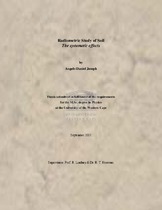| dc.description.abstract | The natural 238U, 232Th and 40K radioactive content of vineyard soil was measured with an in-situ gamma-ray detector. The activity concentrations measured with the in-situ detector are normalized using the laboratory-determined activity concentrations of several samples from the vineyard site.
To determine the activity concentration of a particular soil sample, the gamma-ray photopeak detection efficiencies are required. In this work, the detection efficiencies were derived for each soil sample using gamma-ray photopeaks associated with the radionuclides of 238U and 232Th present in the sample, and the 40K, 1460.8 keV gamma-ray peak, from KCl salt.
The systematic effects related to the gamma ray photopeaks used, the sample moisture and sealing, sample volume or filling height, and sample density, were determined and applied in order to obtain the accurate sample activity concentrations. Assessment of the effect of using specific gamma photopeaks on the activity concentrations was done to confirm that the gamma-ray photopeaks highly prone to coincidence summing were omitted from the efficiency analysis. The effect of sample moisture and sealing suggested that in order to optimize the accuracy of each radioactivity measurement each sample must be oven dried and then hermitically sealed. The effect of volume or filling height
variations of 0.47 % per mm between the sample and KCl standard was derived and this figure was incorporated into the uncertainty in each of the sample activity concentrations. The effect of density variations of less than 5 %, for sample densities ranging from 0.7 g.cm-3 to 1.6 g.cm-3, was determined and incorporated in the efficiency analysis and activity concentration uncertainties. After taking into account all these systematic effects, the soil sample activity concentration uncertainty was found to be no more than 10.4 % at the 95 % confidence level. | en_US |

